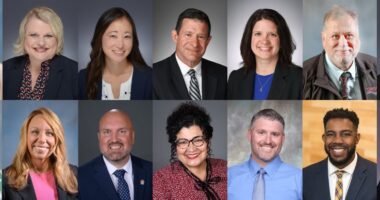After UNITED25: An Energizing and Deeply Affirming Experience With Learning and Connections
A first-time attendee of NAESP’s annual summer conference reflects on her experience and offers advice to other first-time attendees.

Editor’s Note: Every year, NAESP opens the Ann Henley Conference Scholarship in memory of longtime staff member Ann Henley. The scholarship is open to NAESP members who haven’t yet attended an NAESP annual summer conference. Lydia P. Smith is one of three Ann Henley Conference Scholarship recipients in 2025. As a first-time attendee, she’ll be blogging about her experience at 2025 UNITED: The National Conference on School Leadership. You can read more at naesp.org/blog.
Attending UNITED: The National Conference on School Leadership in Seattle was both energizing and deeply affirming. Before the conference, I wrote about my desire to step back from the day-to-day urgency of leading a K–5 school in Oregon and intentionally reconnect with purpose, strategy, and peers. I hoped that this learning space would allow me to “zoom out” so I could return ready to “zoom in” on the work that matters most (supporting instructional leadership and student-centered systems). My experience exceeded those expectations in every way.
Powerful Speakers
One of the most powerful and unexpected highlights was hearing Daymond John speak about his journey. His keynote went beyond business and entrepreneurship. It was a deeply personal, authentic reflection on persistence, identity, and the power of believing in something before the world does. His five “SHARK” points (set a goal, do homework, amor, remember you are the brand, and keep swimming) offered surprising alignment with the work of school leadership. His quote “You need people who look and think like the people you serve” resonated profoundly with my commitment to equity and culturally responsive leadership. It reminded me that every decision we make should be grounded in the identities and lived experiences of the students and families we serve.
Heading into the conference, I was particularly excited about sessions on early literacy, social-emotional learning, and collaborative leadership. These areas are central to our school’s goals, and I wanted actionable strategies to strengthen our systems. Erik Francis’s session on Depth of Knowledge delivered exactly that. He reframed how we think about rigor, not as a checklist of verbs but as a student-centered look at what learning looks like, sounds like, and feels like. “The depth is in the discussion,” he emphasized, a phrase that now serves as a lens I plan to use in classroom walkthroughs, coaching cycles, and staff conversations. One simple, powerful tool he shared was having teachers “circle the verb and highlight what comes after it” to assess task complexity. This approach brings clarity to planning and helps ensure students are engaging with content at a deeper level.
Another standout session was on improvement science and the use of Plan, Do, Study, Act cycles. It reinforced a mindset I’ve been working to grow within my own leadership: the idea that meaningful change is iterative, intentional, and often messy. Improvement doesn’t come from one big initiative; it comes from trial, feedback, and refinement. This learning validated our current efforts around structured coaching and progress monitoring, while also offering sharper tools for how to lead this work with staff.
Perhaps what moved me most across sessions was the consistent call to center students not only in our systems but also in our hearts. Gholdy Muhammad’s keynote on historically responsive education pushed me to reflect more deeply on identity, genius, and joy in learning. Her question “How’s your heart?” is one I carried with me long after the session ended. It challenged me to think not only about how I lead but also why I lead. It reminded me that real equity work begins with love, trust, and joy.
Making Connections
Throughout the conference, I remained intentional about making connections by talking to others in sessions, during breaks, and even in hallway chats. These informal conversations were often the most energizing. As I had hoped in my pre-conference reflection, I walked away not just with a notebook full of ideas but also with a few new colleagues I can reach out to as thought partners beyond the event. There’s a shared understanding among educators at these gatherings. It’s a recognition of the challenges, yes, but it’s also a shared belief in the possibility of something better.
Reflecting on the conference as a whole, I am proud of how I approached the experience. I set out to grow, to listen, to reflect and I was able to do all of that. I pushed myself to network, to ask questions, and to stay focused on the “so what” of every session. I didn’t want to simply be inspired; I wanted to bring back strategies that could immediately impact my school. I now have several new tools to strengthen coaching, elevate student discussion, and make learning more inclusive and joyful. Most important, I have renewed clarity and energy to lead this work.
My Advice to First-Time Attendees
To those attending an NAESP conference for the first time in the future: go with intention but stay open to surprise. Say yes to the conversations. Reflect each evening and remember that the true power of a conference lies not in how much you hear but in what you choose to do with what you’ve heard.
This trip to Seattle was more than a professional development opportunity; it was a reaffirmation of why I do this work. I came home a better version of myself, not just for my staff and students, but for the shared mission we all carry: to lead schools where every child can learn, thrive, and be seen.
Before I go, I would also like to give a heartfelt shout-out to all of the vendors and partners who supported the NAESP conference this year. Your presence added so much value to the experience. From showcasing innovative tools to providing helpful resources and thoughtful giveaways, your contributions helped fuel important conversations and connections. A special thank you to VIRCO, whose display of student-centered, flexible furniture design really stood out. Their commitment to environments that promote engagement and equity was clear, and I’m walking away with ideas on how to reimagine our learning spaces in ways that truly support how kids learn best.
Lydia P. Smith is principal of Ventura Park Elementary in Portland, Oregon.




